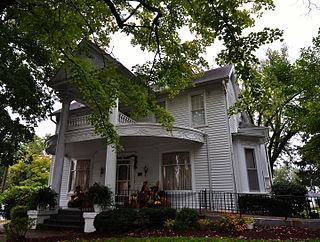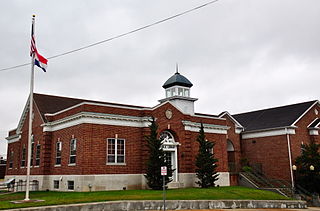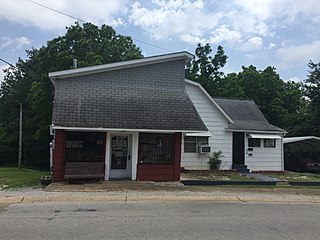
Poplar Bluff is a city in Butler County in southeastern Missouri, United States. It is the county seat of Butler County and is known as "The Gateway to the Ozarks" among other names. The population was 16,225 at the 2020 census. The Poplar Bluff Micropolitan Statistical Area consists of all of Butler County. The city is at the crossroads of U.S. Route 60 and U.S. Route 67.

Natchez On-Top-of-the-Hill Historic District is a historic district in Natchez, Mississippi that was listed on the National Register of Historic Places in 1979.

There are nine historic districts in Meridian, Mississippi. Each of these districts is listed on the National Register of Historic Places. One district, Meridian Downtown Historic District, is a combination of two older districts, Meridian Urban Center Historic District and Union Station Historic District. Many architectural styles are present in the districts, most from the late 19th century and early 20th century, including Queen Anne, Colonial Revival, Italianate, Art Deco, Late Victorian, and Bungalow.

Hillsborough Historic District is a national historic district located at Hillsborough, Orange County, North Carolina. The district encompasses 529 contributing buildings, 9 contributing sites, 13 contributing structures, and 2 contributing objects in the central business district and surrounding residential sections of Hillsborough. The district includes buildings dating to the late-18th and early-20th century and includes notable examples of Federal, Greek Revival, and Italianate style architecture. Located in the district are the separately listed Burwell School, Eagle Lodge, Hazel-Nash House, Heartsease, Montrose, Nash Law Office, Nash-Hooper House, Old Orange County Courthouse, Poplar Hill, Ruffin-Roulhac House, Sans Souci, and St. Matthew's Episcopal Church and Churchyard. Other notable buildings include Seven Hearths, the Presbyterian Church (1815-1816), Methodist Church (1859-1860), First Baptist Church (1862-1870), Twin Chimneys, and the Berry Brick House.

The St. Charles Historic District is a national historic district located at St. Charles, St. Charles County, Missouri. It is the site of the first permanent European settlement on the Missouri River and of the embarkation of Lewis and Clark's journey of exploration along the Missouri. The first state capital of Missouri and over one hundred other historic buildings are located in the district.

College Square Historic District is a nationally recognized historic district located on a bluff north of downtown Davenport, Iowa, United States. It was listed on the National Register of Historic Places in 1983. The district derives it name from two different colleges that were located here in the 19th century.

The Hamburg Historic District, also known as the Gold Coast, is a residential neighborhood located on a bluff northwest of downtown Davenport, Iowa, United States. It is listed on the National Register of Historic Places in 1983. In 1999, it was listed on the Davenport Register of Historic Properties The historic district is where the city's middle and upper-income German community built their homes in the 19th and early 20th centuries. Germans were the largest ethnic group to settle in Davenport.

The Fifth Street Bluff Historic District is a nationally recognized historic district located in Ottumwa, Iowa, United States. It was listed on the National Register of Historic Places in 1998. At the time of its nomination it contained 67 resources, which included 40 contributing buildings, three contributing structures, and 24 non-contributing buildings.

Moore-Dalton House, also known as the Margaret Harwell Art Museum, is a historic home located at Poplar Bluff, Butler County, Missouri. It was originally built in 1883, and remodeled to its present form in 1896. It is a two-story, frame dwelling on a brick and stone foundation. It features a Classical Revival style semi-circular front portico with fluted Ionic columns and a second story balcony. The house was converted to an art museum by the city of Poplar Bluff in 1979.

Poplar Bluff Municipal Library (Poplar Bluff Public Library) is a historic library building located at Poplar Bluff, Butler County, Missouri. It was built in 1936, and is a one-story, Colonial Revival style brick building. It sits on a full basement and has a gable roof.
Poplar Bluff Commercial Historic District is a national historic district located at Poplar Bluff, Butler County, Missouri. It encompasses 14 contributing commercial buildings in the central business district of Poplar Bluff. The district developed between about 1880 and 1930s, and includes representative examples of Italianate and Colonial Revival style architecture. Notable buildings include the Fraternal Building (1928) and Begley Building (1908).
South Sixth Street Historic District is a national historic district located at Poplar Bluff, Butler County, Missouri. It encompasses four contributing buildings and two contributing structures in a residential section of Poplar Bluff. The district developed between about 1880 and 1917, and includes representative examples of Italianate and Colonial Revival style architecture. Notable buildings include the Luke F. Quinn House (1884), the Warren S. Randall House (1889), and John C. Corrigan House (1917).
Cynthia–Kinzer Historic District is a national historic district located around Cynthia and Kinzer Streets, Poplar Bluff, Missouri. It encompasses 55 contributing buildings 1 contributing site, and 17 contributing structures in a predominantly residential section of Poplar Bluff. The district developed between about 1907 and 1961, and includes representative examples of Colonial Revival, Tudor Revival, Bungalow / American Craftsman, and International style architecture. Located in the district are the separately listed Alfred W. Greer House and J. Herbert Moore House. Other notable buildings include the Fred Anderson House, Hubert C. Roland House, Lyle Kutchback House, Lawrence and Alma Tedrick House, C.P. Schultz House, J. Truman and Lena Carter House, Carl Capps House, and James and Nelda McPheeters House.

The Willow–Bluff–3rd Street Historic District is a nationally recognized historic district located in Council Bluffs, Iowa, United States. It was listed on the National Register of Historic Places in 2005. At the time of its nomination the district consisted of 260 resources, including 162 contributing buildings, 56 contributing structures, 36 non-contributing buildings, and six non-contributing structures. The district is primarily a residential area that is adjacent to the central business district to the west. Part of the district is in Jackson's Addition, which is the first addition to the original town of Council Bluffs. It also sits along the base of the loess bluffs to the east.

Main and Eighth Streets Historic District is a national historic district located at Joplin, Jasper County, Missouri. The district encompasses 20 contributing buildings in the central business district of Joplin. It developed between about 1891 and 1929 and includes representative examples of Renaissance Revival and Colonial Revival style architecture. Located in the district is the previously listed Rains Brothers Building. Other notable buildings include the Marquette Hotel, Willard Hotel, Muir Block (1891), Stevens Hotel / Scottish Rite Temple (1899), and Hotel Blende (1899).

The Sedalia Commercial Historic District is a national historic district located at Sedalia, Pettis County, Missouri. It encompasses 102 contributing buildings in the central business district of Sedalia. The district developed between about 1870 and 1959, and includes representative examples of Italianate, Romanesque Revival, and Art Deco architecture. Located in the district are the separately listed Hotel Bothwell, Building at 217 West Main Street, and Missouri/Sedalia Trust Company. Other notable buildings include the First United Methodist Church (1888-1891), Pettis County Courthouse (1924), Anheuser Busch Bottling Works, the New Lona Theater (1920), Citizens National Bank Building, Third National Bank (1929), Federal Building (1930), Montgomery Ward Building (1936), the Uptown Theatre (1936), Missouri Pacific Depot, and Central Presbyterian Church.

North Third Street Historic District is a national historic district located at Louisiana, Pike County, Missouri. The district encompasses 61 contributing buildings, one contributing site, and contributing structure in a predominantly residential section of Louisiana. It developed between about 1843 and 1935 and includes representative examples of Greek Revival, Gothic Revival, Italianate, Queen Anne, Colonial Revival, and Bungalow/American Craftsman style architecture. Located in the district are the separately listed Louisiana Public Library and Luce-Dyer House. Other notable buildings include the William C. Hardin House, James H. Johnson House, Edward G. McQuie House, St. Joseph's Catholic Church (1874), and Frank Boehm, Jr. House.

Midtown Neighborhood Historic District is a national historic district located at St. Charles, St. Charles County, Missouri. The district encompasses 527 contributing buildings, 7 contributing sites, and 5 contributing objects in a predominantly residential section of St. Charles. It developed between about 1838 and 1959, and includes representative examples of Federal, Greek Revival, Gothic Revival, Italianate, Queen Anne, Romanesque Revival, Folk Victorian, Colonial Revival, Classical Revival, Tudor Revival, and Bungalow / American Craftsman style architecture. Located in the district are the separately listed African Church and Oliver L. and Catherine Link House. Other notable buildings include the St. Charles County Courthouse, Benton School (1896), St. John's A.M.E. Church (1872), Immanuel Lutheran Church (1867), Jefferson Street Presbyterian Church, Fourth Street Market Grocery (1926-1927), West End Grocery and Meat Market, Dr. Ludwell Powell House (1838), Rogers-Ehrhard House, Waye Monument Company and Residence (1889), Meyer House, Kaemmerlen House, and Elsner House.

The White Cloud Historic District is a 41.3 acres (16.7 ha) historic district in White Cloud, Kansas which was listed on the National Register of Historic Places in 1996. It is roughly bounded by Poplar, 6th, Chesnut Sts. and K-7 and included 67 contributing buildings and a contributing site, as well as 15 non-contributing buildings and a non-contributing site.

The Garfield Historic District in Poplar Bluff, Missouri is a historic district which was listed on the National Register of Historic Places in 2017. It encompasses three contributing buildings and one contributing object in a predominantly residential section of Poplar Bluff.






















